Neurodeterminism as an antidote to common sense? I doubt it!
8 reasons that worksheets work for Computing
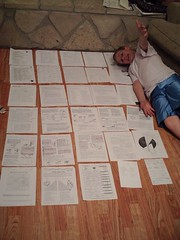 The use of worksheets is often derided. You hear expressions like “death by a thousand worksheets”, and even a Government Education minister (now ex-Minister for Education) has weighed in, saying that teachers should use textbooks instead of worksheets [1].
The use of worksheets is often derided. You hear expressions like “death by a thousand worksheets”, and even a Government Education minister (now ex-Minister for Education) has weighed in, saying that teachers should use textbooks instead of worksheets [1].
Leaving aside the observation that how teachers teach is, in my opinion, none of the Government’s business – it’s the equivalent of telling doctors to use electronic blood pressure monitors rather than the manual kind – there are perfectly compelling reasons to use worksheets in the Computing classroom.
Quick look: Literacy from Scratch
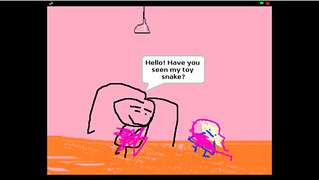 If you’re concerned that young children won’t be able to grasp computing concepts, or are worried about how you’re going to teach it, have a look around the Literacy from Scratch website.
If you’re concerned that young children won’t be able to grasp computing concepts, or are worried about how you’re going to teach it, have a look around the Literacy from Scratch website.
Managed – and, I think, written by – Lawrence Williams, the website contains examples of pupils’ work in Scratch, cross-curricular ideas and examples, and notes on pedagogy.
Review of Espresso Coding
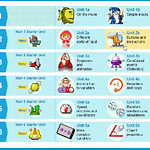 This application is designed to teach Computing at Key Stages 1 and 2 (a more sophisticated version for older pupils is being worked on).
This application is designed to teach Computing at Key Stages 1 and 2 (a more sophisticated version for older pupils is being worked on).
What struck me immediately on using it is the amount of guidance available, both in verbal form and videos. There is quite a large range of modules to choose from, including “Starter” ones which take you through the basics and, where appropriate, recapitulate what has already been learnt.
Review of Code Academy
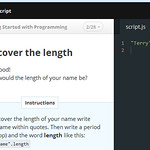 Code Academy is an online tutorial-based website for teaching yourself how to code. You can select which programming language you wish to learn, from the following list
Code Academy is an online tutorial-based website for teaching yourself how to code. You can select which programming language you wish to learn, from the following listReview of J2Code
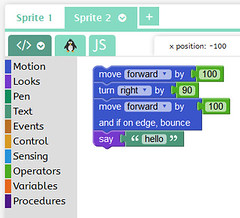 As usual, I gave this application a workout without seeking help from a manual or anything like that – which is just as well because there does not seem to be a comprehensive manual.
As usual, I gave this application a workout without seeking help from a manual or anything like that – which is just as well because there does not seem to be a comprehensive manual.
There are three applications in one: JIT5, LOGO and Visual. This is quite useful because if you are familiar with LOGO but not JavaScript, you can start pupils coding in an environment that is familiar to you. Also, if you teach very young children, JIT5 is highly visual and colourful.
An advantage of J2Code as a whole over 2Code is that it covers the age range from Key Stage 1 (5-6 year olds) to Key Stage 3 (13-14 year olds).
The usefulness of technology in education
 Strangely enough, the most popular blog post on this website is 13 reasons to use educational technology in lessons. Why strange? Because I wrote it over three years ago. I re-read it recently, and (thank goodness!) I still agree with what I wrote all that time ago. I’d like to add more to it, but rather than do that I thought I would contribute to Mark Anderson’s series on this subject.
Strangely enough, the most popular blog post on this website is 13 reasons to use educational technology in lessons. Why strange? Because I wrote it over three years ago. I re-read it recently, and (thank goodness!) I still agree with what I wrote all that time ago. I’d like to add more to it, but rather than do that I thought I would contribute to Mark Anderson’s series on this subject.Review of 2Code
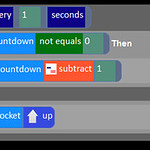 2Simple’s answer to the question “How can we teach coding to little ones?” is 2Code. The first thing that greets you when you go to the 2Code section of Purple Mash is the plethora of files to open.
2Simple’s answer to the question “How can we teach coding to little ones?” is 2Code. The first thing that greets you when you go to the 2Code section of Purple Mash is the plethora of files to open.Review of Computing Without Computers
Project-based learning in the Computing curriculum
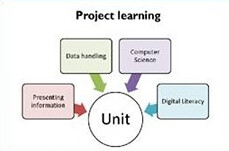 John Partridge, Assistant Head for eLearning, explains how Computing is taught through a project-based learning approach at his school.
John Partridge, Assistant Head for eLearning, explains how Computing is taught through a project-based learning approach at his school.
I remember clearly looking at the first draft of the new curriculum and just being totally shocked by the degree of change. It had been clearly signalled that the new draft would be a step-change, but I didn’t appreciate the shift which was about to take place. Almost nothing remained from the previous programme, save a few references to digital resources and, in a later draft, safe use of technology. So it was clear that some serious work was going to be needed to make sure our school adapted.
three cheers for antiplagiarism software
 I like to think that had there been anti-plagiarism software around when I was at school, and had my English teacher used it, I’d have been saved years of wasting time looking for ways to make money. I’d have enjoyed more sleep too.
I like to think that had there been anti-plagiarism software around when I was at school, and had my English teacher used it, I’d have been saved years of wasting time looking for ways to make money. I’d have enjoyed more sleep too.Preparing to teach the new Computing curriculum
 I've been giving talks on preparing for the new Computing curriculum, and as well as waxing lyrical that also involves listening to others' concerns. It also means hearing about some innovative approaches that colleagues have adopted.
I've been giving talks on preparing for the new Computing curriculum, and as well as waxing lyrical that also involves listening to others' concerns. It also means hearing about some innovative approaches that colleagues have adopted.
At the same time, I have been conducting a survey of what people have been doing to prepare for the new curriculum. I'll be publishing the results in due course. In fact, some of the resources mentioned in the collection of coding resources in the early July 2014 edition of Digital Education came to my attention from that survey.
So, given that at the time of writing there's about 2 or 3 days to go till the end of term, what can you realistically do at this stage to prepare for September?
Digital Education latest edition!
Should we welcome the nanocams?
I’m reading a short story by Ian Creasey called “The Edge of the Map”. In the world depicted by Creasey, automated cameras called “nanocams” take photos and newspapers (and other media, presumably) source their illustrations from the pool created by them. In other words, there is no need for specialist photographers.
This raises a number of interesting questions.
Awarding Levels in Computing for the purpose of number-crunching
A is for Assessing Computing: 16 criteria and 5 considerations
The 6 Fundamental Computing Assessment Scheme Questions
Digital Education Coding Resources Special
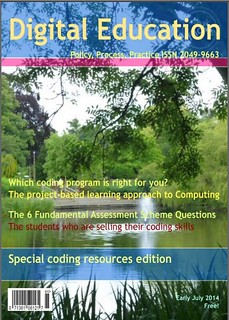 The new edition of Digital Education, the free newsletter for those with a professional interest in educational ICT and Computing, has a special focus on resources you can use to teach coding. Here’s what it contains:
The new edition of Digital Education, the free newsletter for those with a professional interest in educational ICT and Computing, has a special focus on resources you can use to teach coding. Here’s what it contains:Digital Education–Latest Edition
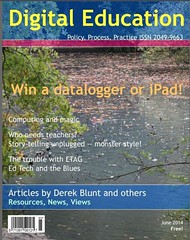 This is what the latest version of Digital Education contains, with guest articles by Professor Paul Curzon, Sal McKeown, Geoff Jones and Crispin Weston
This is what the latest version of Digital Education contains, with guest articles by Professor Paul Curzon, Sal McKeown, Geoff Jones and Crispin Weston